人教高二英语上册全册知识点大汇总
高二英语必背知识点人教版
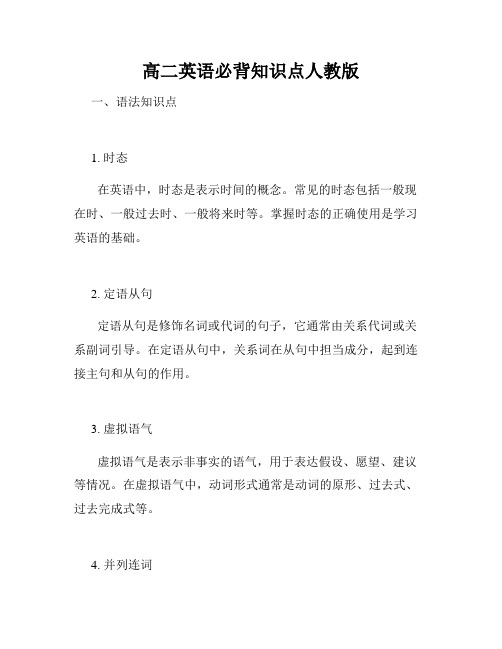
高二英语必背知识点人教版一、语法知识点1. 时态在英语中,时态是表示时间的概念。
常见的时态包括一般现在时、一般过去时、一般将来时等。
掌握时态的正确使用是学习英语的基础。
2. 定语从句定语从句是修饰名词或代词的句子,它通常由关系代词或关系副词引导。
在定语从句中,关系词在从句中担当成分,起到连接主句和从句的作用。
3. 虚拟语气虚拟语气是表示非事实的语气,用于表达假设、愿望、建议等情况。
在虚拟语气中,动词形式通常是动词的原形、过去式、过去完成式等。
4. 并列连词并列连词是连接两个独立的句子或词组的重要工具。
常见的并列连词有and、but、or等,它们能够起到连接作用,并且可以使句子结构更加丰富多样。
5. 介词和介词短语介词是一种辅助词,常用来表示方位、时间、原因等关系。
介词短语由介词和其它成分组成,可以在句子中起到修饰名词或代词的作用。
6. 被动语态被动语态是表示动作的承受者是谓语动词的一种语态。
被动语态的构成是由助动词be加上过去分词形成,它常用于强调动作的承受者,或者主语无法确定的情况。
二、词汇知识点1. 同义词同义词是指意义相近的词语,它们之间的差别主要在于用法、感情色彩等方面。
学习同义词可以丰富词汇量,提高语言表达的准确性。
2. 反义词反义词是指意义相反的词语,它们之间的对比可以帮助理解词语的意义。
熟练掌握反义词可以提高语言的灵活运用能力。
3. 词根和词缀词根是构成单词的基本单位,一般表示词语的核心意义。
词缀是附加在词根上的一个字母或字母组合,用以改变词根的意义或词性。
学习词根和词缀可以帮助记忆和理解各种词语。
4. 时态相关词汇时态相关词汇是指与时态紧密相关的词汇,包括动词的不同形式、时间状语等。
掌握时态相关词汇可以帮助准确表达过去、现在和将来的事实、习惯和计划等。
5. 常用短语和习惯用语常用短语和习惯用语是日常英语中经常出现的固定搭配,学好这些短语和用法可以提高听说能力,使语言更加地道和流利。
人教高二上册英语知识点
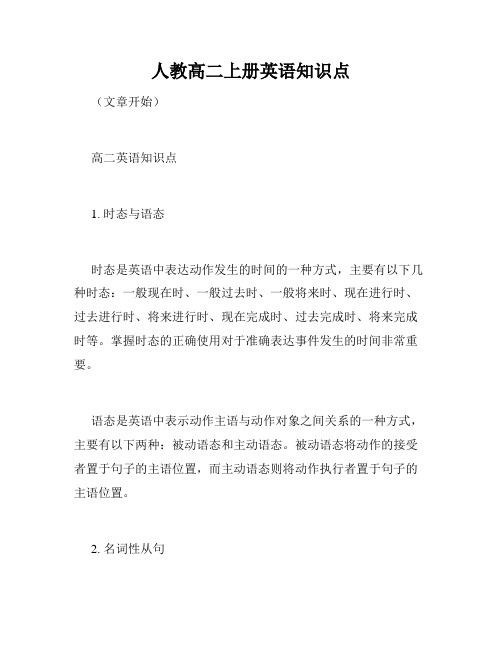
人教高二上册英语知识点(文章开始)高二英语知识点1. 时态与语态时态是英语中表达动作发生的时间的一种方式,主要有以下几种时态:一般现在时、一般过去时、一般将来时、现在进行时、过去进行时、将来进行时、现在完成时、过去完成时、将来完成时等。
掌握时态的正确使用对于准确表达事件发生的时间非常重要。
语态是英语中表示动作主语与动作对象之间关系的一种方式,主要有以下两种:被动语态和主动语态。
被动语态将动作的接受者置于句子的主语位置,而主动语态则将动作执行者置于句子的主语位置。
2. 名词性从句名词性从句是在复合句中充当名词成分的从句,可以用来充当主语、宾语、表语和同位语,常见的名词性从句有主语从句、宾语从句、表语从句和同位语从句。
在使用名词性从句时,需注意从句与主句的时态、语态和语序的一致性。
3. 定语从句定语从句是在复合句中充当定语的从句,用来修饰名词或代词。
一般由关系词引导,关系词有关系代词(如who, which, that)和关系副词(如when, where, why)。
4. 状语从句状语从句是在复合句中充当状语的从句,用来修饰谓语动词、形容词或副词。
根据状语从句表达的内容不同,可分为时间状语从句、条件状语从句、原因状语从句、结果状语从句、方式状语从句和目的状语从句等。
5. 状语和状语从句的区别状语是修饰动词、形容词或副词的短语,可以由介词短语、副词短语、分词短语等构成。
状语和状语从句的区别在于状语是短语结构,而状语从句是从句结构。
6. 主谓一致主谓一致是指主语和谓语动词在人称和数上保持一致。
一般来说,单数主语使用单数谓语动词,复数主语使用复数谓语动词。
但在某些特殊情况下,如集体名词作主语时,谓语动词的形式可能会与主语的状态有所不同。
7. 倒装句倒装句是英语中的一种语法结构,即将谓语动词或助动词提前至主语之前的句子。
倒装句有两种情况:完全倒装和部分倒装。
完全倒装是将整个谓语动词或助动词提前,部分倒装是将助动词或情态动词提前。
人教高二英语上册全册知识点大汇总

人教高二英语上册知识点大汇总目录Unit1 Great scientists 知识点归纳 (2)Unit2 The United Kingdom 知识点归纳 (6)Unit3 Life in the Future 知识点归纳 (10)Unit4 Making the News 知识点归纳 (14)Unit5 First aid 知识点归纳 (22)Unit 1 Great scientists 知识点归纳【重点词汇、短语】1. put forward 提出2. conclude 结束,结论3. draw a conclusion 得出结论4. defeat 打败5. attend 照顾,护理,出席6. expose to 使显露7. cure 治愈,治疗8. challenge 挑战9. suspect 怀疑,被怀疑者10. blame 责备11. handle 柄,把手,处理,掌控12. link 联系,连接13. link to 将…和…连接14. announce 宣布15. contribute 捐献,贡献16. apart from 除了17. be strict with 对…严格18. make sense 讲的通,有意义19. spin 使旋转20. reject 拒绝,抛弃【重点句型】1. What do you know about infectious diseases?你对传染性疾病了解多少?2. John Snow was a famous doctor in London –so expert, indeed, that he attended Queen Victoria as her personal physician.约翰•斯诺是伦敦一位著名的医生——他的确医术精湛,因而成为维多利亚女王的私人大夫。
3. But he became inspired when he thought about helping ordinary people exposed to cholera.但当他一想到要帮助患了霍乱的普通老百姓,他就感到很振奋。
人教高二英语知识点归纳复习

幻灯片1幻灯片21. run out ofrun out of 是新课标重点短语。
考查角度常为:①run out of的主语是人时,表示“某人用光了某物”,同义短语是use up。
②run out的主语是物时,其后不跟宾语,无被动,表示“某物”被用光,同义短语有give out。
幻灯片33. specificspecific 是新课标重点词汇。
①作形容词时意为“确切的,特定的”;作名词时意为“特性,特效药,详情”。
②注意specific与special在词形上相近,但意义不同。
4. take it easytake it easy 是高考中经常出现的考点。
(2008·浙江),(2008·山东),(2008·辽宁),(2007·重庆),(2007·天津)中都有对此短语的考查。
高考对于此短语的考查方式主要有两种:①与其他短语的辨析:take things easy, take one s time 等。
②与含take的短语之间的辨析,如:take off/away/down/up等。
预测2010 高考仍可能会在单项填空,完形填空中出现关于take短语的辨析。
5. with+复合宾语with+复合宾语是高考重要的考查句式。
(2008·全国Ⅱ),(2007·安徽)都对这一点进行了考查。
考查方向主要是复合宾语中的宾补可以由多种成分担当,尤其是do,doing,还有done。
预测2010 高考中可能还会通过此句式考查学生的句式判断能力和与非谓语动词作宾补的辨析。
幻灯片41. ___ adj.抽象的;深奥的;n. 摘要→____ adj.(反义词)具体的2.____ n.信任;信心;信念→____ adj忠实的→____ adv. 忠实地3. ____ adv. 所以; 因而→_____ adj. 作为结果的;随之发生的→____ n. 结果4. ____ n.目标;目的;v.瞄准,(向某方向)努力→____ adj.(反义词)漫无目的的5.____adj. 常规的;传统的;因循守旧的→____ adv. 常规地;传统地1.abstract; concrete2.faith; faithful; faithfully3.consequently; consequent; consequence4.aim; aimless5.conventional; conventionally幻灯片56. ____ adj. 典型的;有代表性的→____ adv. 典型地;有代表性地7. ____ adj. 明显的;显著的→_____ n. 证据8. ____vt. 采用;采纳;收养→_____adj. 被收养的;被采纳的;有收养关系的9. ____vt. 拥有;具有;支配→_____ n.(尤作复数)所有;财产10. _____ adj. 荒谬的;可笑的→_____ adv. 荒谬地11. _____adj. 争论的;争议的→____ n. 争论;论战12. _____vt. 预言;预告;预测→____ n. 预言;预告13. _____ adj. 确切的;特定的→_____ adv. 确切地;特定地14. _____adj. 敢作敢为的;侵略的;好斗的→_____ n. 攻击;侵犯15. ____ v. 呼吁;求助;将……上诉;n. 呼吁;恳求→_____ adj. 可怜的;恳求的;有魅力的;令人感兴趣的16._____ n. 文明;文化→_____ v. 使文明; 使开化;教化6.typical;typically7.evident;evidence8.adopt;adoptive9.possess;possession10.ridiculous; ridiculously 11.controversial; controversy12.predict; prediction13.specific;specifically 14.aggressive;aggression15.appeal;appealing16.civilization;civilize幻灯片61. ____ coincidence 偶然地;巧合地2. a _____ deal 许多;大量3. on the _____ hand(可是)另一方面4. in the ____ 活着的;本人5. appeal ____ (对某人)有吸引力;(使某人)感兴趣6. lead _____ 导致7. concentrate ____ 集中注意力于……8. be _____ to do sth. 渴望做某事9. as ____ as 既;又10. would _____ 宁愿1.by2.great3.other4.flesh5.to6.to7.on8.eager9.well 10.rather幻灯片7take aim at sth. 向……瞄准without aim 漫无目的地aim at doing/to do sth.旨在做某事be aimed at 目的是……with the aim of 意在……aim at sth.旨在……achieve one’s aim 达到(某人的)目的miss one’s aim 失去目标;失败aimless adj.无目的的用aim的适当形式填空。
高二上册英语知识点归纳梳理
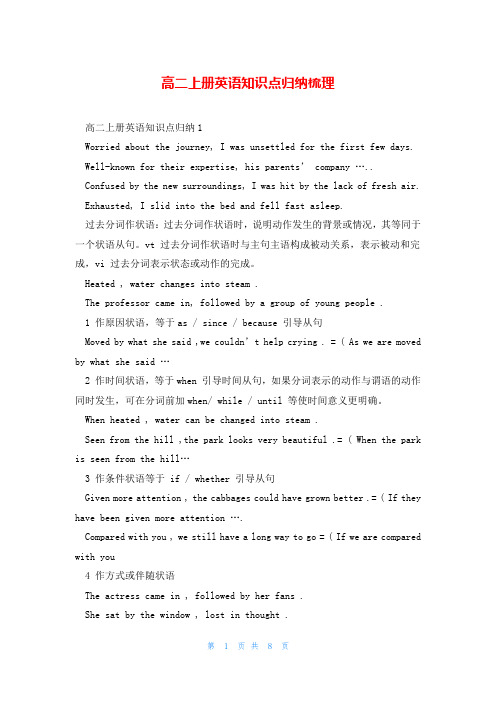
高二上册英语知识点归纳梳理高二上册英语知识点归纳1Worried about the journey, I was unsettled for the first few days. Well-known for their expertise, his parents’company …..Confused by the new surroundings, I was hit by the lack of fresh air. Exhausted, I slid into the bed and fell fast asleep.过去分词作状语:过去分词作状语时,说明动作发生的背景或情况,其等同于一个状语从句。
vt 过去分词作状语时与主句主语构成被动关系,表示被动和完成,vi 过去分词表示状态或动作的完成。
Heated , water changes into steam .The professor came in, followed by a group of young people .1 作原因状语,等于as / since / because 引导从句Moved by what she said ,we couldn’t help crying . = ( As we are moved by what she said …2 作时间状语,等于when 引导时间从句,如果分词表示的动作与谓语的动作同时发生,可在分词前加when/ while / until 等使时间意义更明确。
When heated , water can be changed into steam .Seen from the hill ,the park looks very beautiful .= ( When the park is seen from the hill…3 作条件状语等于 if / whether 引导从句Given more attention , the cabbages could have grown better .= ( If they have been given more attention ….Compared with you , we still have a long way to go = ( If we are compared with you4 作方式或伴随状语The actress came in , followed by her fans .She sat by the window , lost in thought .5 作让步状语Much tired ,he still kept on working .=(Although he was tired ,) he ….6 独立主格结构:当分词的逻辑主语不是主句主语时,分词可以有自己独立的逻辑主语,这种结构称为独立主格结构。
高二人教版英语知识点总结
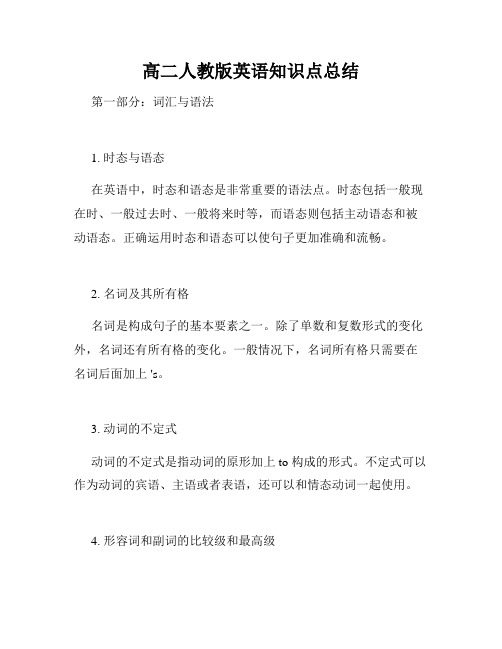
高二人教版英语知识点总结第一部分:词汇与语法1. 时态与语态在英语中,时态和语态是非常重要的语法点。
时态包括一般现在时、一般过去时、一般将来时等,而语态则包括主动语态和被动语态。
正确运用时态和语态可以使句子更加准确和流畅。
2. 名词及其所有格名词是构成句子的基本要素之一。
除了单数和复数形式的变化外,名词还有所有格的变化。
一般情况下,名词所有格只需要在名词后面加上 's。
3. 动词的不定式动词的不定式是指动词的原形加上 to 构成的形式。
不定式可以作为动词的宾语、主语或者表语,还可以和情态动词一起使用。
4. 形容词和副词的比较级和最高级形容词和副词可以有比较级和最高级形式,用来表达事物的比较和最高程度。
比较级通常在形容词或副词前面加上 er,最高级则加上 est。
5. 状语从句状语从句是指在句子中充当状语的从句。
常见的状语从句包括时间状语从句、条件状语从句和原因状语从句等。
状语从句的引导词有 when、if、because 等。
第二部分:阅读理解1. 主旨大意题主旨大意题是阅读理解中的常见题型,要求根据文章的内容确定文章的主题或主旨。
解答主旨大意题时要注意把握文章的中心思想,避免陷入细节。
2. 事实细节题事实细节题要求根据文章中的具体信息进行判断。
解答这类题时要仔细阅读文章,寻找与题目相关的关键词,并根据上下文推断答案。
3. 推理判断题推理判断题要求根据文章中的暗示或推理进行判断。
解答这类题时要注意找到文章中的线索,进行合理的推理。
4. 词汇推测题词汇推测题要求根据上下文的语境猜测生词的含义。
解答这类题时要注意根据句子的语法结构和上下文的逻辑关系进行推测。
第三部分:写作技巧1. 英语写作的基本结构英语写作通常包括引言、论点和结论三个部分。
引言部分用于引入话题,论点部分用于陈述观点和论证,结论部分用于总结观点。
2. 表达观点和论证在写作中,要清楚表达自己的观点,并使用合理的论据进行论证。
在论证过程中,可以运用因果关系、对比、举例等方法。
人教版高二(上)英语知识清单:重...
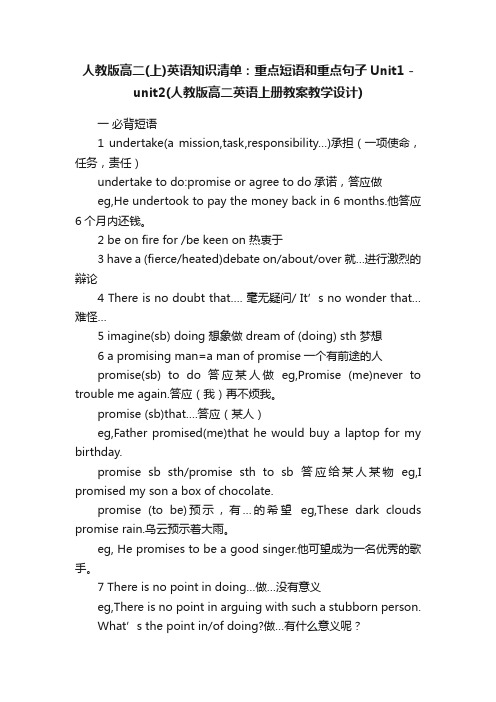
人教版高二(上)英语知识清单:重点短语和重点句子Unit1 -unit2(人教版高二英语上册教案教学设计)一必背短语1 undertake(a mission,task,responsibility…)承担(一项使命,任务,责任)undertake to do:promise or agree to do承诺,答应做eg,He undertook to pay the money back in 6 months.他答应6个月内还钱。
2 be on fire for /be keen on 热衷于3 have a (fierce/heated)debate on/about/over 就…进行激烈的辩论4 There is no doubt that…. 毫无疑问/ It’s no wonder that…难怪…5 imagine(sb) doing 想象做 dream of (doing) sth 梦想6 a promising man=a man of promise一个有前途的人promise(sb) to do 答应某人做eg,Promise (me)never to trouble me again.答应(我)再不烦我。
promise (sb)that….答应(某人)eg,Father promised(me)that he would buy a laptop for my birthday.promise sb sth/promise sth to sb答应给某人某物eg,I promised my son a box of chocolate.promise (to be)预示,有…的希望eg,These dark clouds promise rain.乌云预示着大雨。
eg, He promises to be a good singer.他可望成为一名优秀的歌手。
7 There is no point in doing…做…没有意义eg,There is no point in arguing with such a stubborn person.What’s the point in/of doing?做…有什么意义呢?eg,What’s the point of regretting it after the break-up?分手之后再后悔有什么意义?the point is …(=the most important thing is ….)最重要的是,问题是eg You are quite capable,but the point is that you aren’t confident enough.你是相当有能力的,但问题是你不够自信。
高二上英语知识点课本人教版
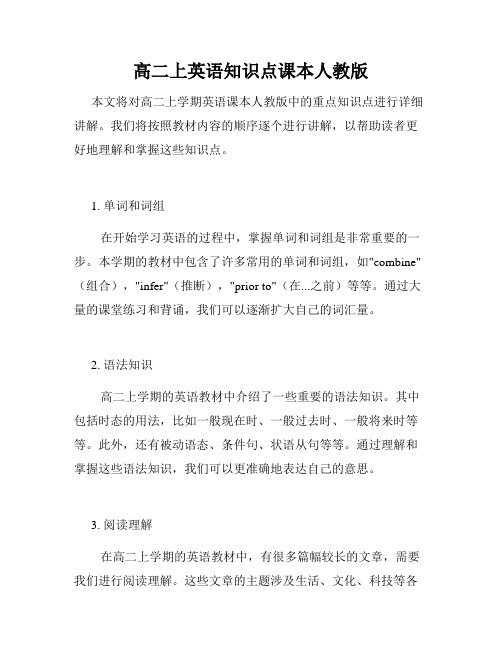
高二上英语知识点课本人教版本文将对高二上学期英语课本人教版中的重点知识点进行详细讲解。
我们将按照教材内容的顺序逐个进行讲解,以帮助读者更好地理解和掌握这些知识点。
1. 单词和词组在开始学习英语的过程中,掌握单词和词组是非常重要的一步。
本学期的教材中包含了许多常用的单词和词组,如"combine"(组合),"infer"(推断),"prior to"(在...之前)等等。
通过大量的课堂练习和背诵,我们可以逐渐扩大自己的词汇量。
2. 语法知识高二上学期的英语教材中介绍了一些重要的语法知识。
其中包括时态的用法,比如一般现在时、一般过去时、一般将来时等等。
此外,还有被动语态、条件句、状语从句等等。
通过理解和掌握这些语法知识,我们可以更准确地表达自己的意思。
3. 阅读理解在高二上学期的英语教材中,有很多篇幅较长的文章,需要我们进行阅读理解。
这些文章的主题涉及生活、文化、科技等各个方面。
我们需要仔细阅读并理解文章的内容,同时学习如何从文章中获取信息、推断作者意图等技巧。
4. 写作技巧在教材中,也有一些关于写作的内容。
写作是英语学习的重要环节,通过写作可以更好地提高自己的英语表达能力。
教材中介绍了一些写作技巧,如如何写一篇完整的短文、如何进行段落分隔等。
我们可以通过模仿教材中的写作示范,不断练习来提高自己的写作水平。
5. 听力和口语练习学习英语不仅仅是理解文本,还需要能够听懂和流利地口语表达。
教材中提供了一些听力材料和口语练习,通过反复练习,我们可以提高自己的听力理解和口语表达能力。
通过学习高二上学期的英语知识点课本人教版,我们可以打下坚实的英语基础。
掌握这些知识点,不仅可以在考试中取得好成绩,更重要的是能够应用于日常交流中,提升自己的实际英语能力。
希望本文对读者能有所帮助,祝愿大家在英语学习的道路上取得更进一步的成绩!。
2022-2023学年人教版高二英语选择性必修第一册重要知识点汇总 讲义

高二英语重点知识高二英语知识点总结11.一般现在时:一般现在时大多用动词原形来表示。
Be\have在人称和数上应按自己的变化规则与主语保持一致。
其他动词若其主语是第三人称单数,则应按动词第三人称单数的变化规律变化。
(1)表示主语现在所处的状态及所具备的特征、性格、能力等。
Eg:They are both tired and hungry.(2)表示习惯性的,反复出现的动作与状态。
常用时间状语:always often sometimes now and then every day(3)表示客观事实或普遍真理。
Eg:The earth moves around the sun.(4)在时间状语从句和条件状语从句表示将来的动作。
Eg:If it doesn’t rain tomorrow,we will go climbing.(5)表示按规定预计要发生的动作,只限于go,come,leave,start,stay,return,begin等。
(6)在某些以have,there开头的句子中,用动词go,come的一般现在时表示正在发生的动作。
Eg:Here comes the bus!2.现在进行时:(1)表示说话时正在进行的动作;(2)表示即将发生的或按计划安排好的动作,多限于go,come,start,leave,return,arrive,stay,fly等表示运动方向的动词,句中往往有表示将来的时间状语。
(3)少数动词如go,come,leave,arrive,return,begin,do,die,lose等现在进行时可以表示预计即将发生的动作;(4)表示反复发生的动作。
3.以-ing和-ed结尾的形容词:以-ed结尾的形容词用来描述人的精神状态或人对事物的态度或感受;以-ing结尾的形容词有“令人......的”意思,常用来指物。
高二英语知识点总结2A: Key Words and Expressions:1. Which of the news media above is the most reliable? 以上的新闻媒体中哪一种最可靠?reliable adj. 可信赖的; 可依靠的; 确定的They are reliable friends. 他们是可信赖的朋友。
人教版高二英语上册知识点汇总 赶快收藏哦!
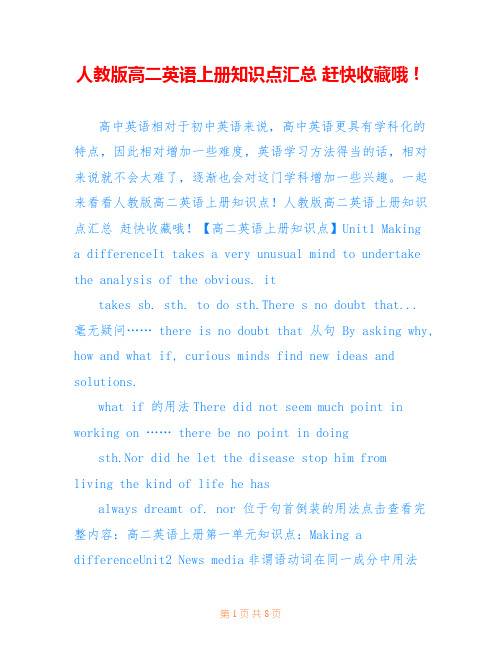
人教版高二英语上册知识点汇总赶快收藏哦!高中英语相对于初中英语来说,高中英语更具有学科化的特点,因此相对增加一些难度,英语学习方法得当的话,相对来说就不会太难了,逐渐也会对这门学科增加一些兴趣。
一起来看看人教版高二英语上册知识点!人教版高二英语上册知识点汇总赶快收藏哦!【高二英语上册知识点】Unit1 Making a differenceIt takes a very unusual mind to undertake the analysis of the obvious. ittakes sb. sth. to do sth.There s no doubt that...毫无疑问…… there is no doubt that 从句By asking why, how and what if, curious minds find new ideas and solutions.what if 的用法There did not seem much point in working on …… there be no point in doingsth.Nor did he let the disease stop him fromliving the kind of life he hasalways dreamt of. nor 位于句首倒装的用法点击查看完整内容:高二英语上册第一单元知识点:Making a differenceUnit2 News media非谓语动词在同一成分中用法的辨析1.做主语:-般来说,不定式和动名词成份相同时,表示客观性、一般性行为为多用动名词表示,而表示一次性、具体性行为则多用不定式。
Looking after children is her job.To clean the classroom is his job today.2.做宾语:I like swimming, but I don t like to swim today because I don t feelwell.(1).有些动词只能接不定式做宾语,这些动词接上不定式,含有明显的主观性和将来性意义。
人教版高二上册英语知识点总结
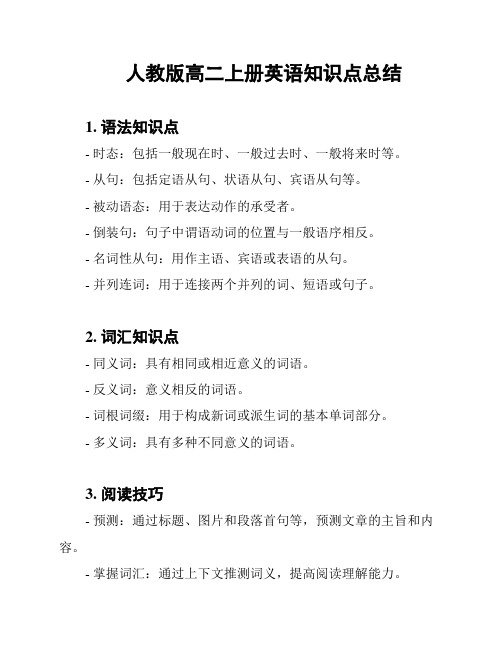
人教版高二上册英语知识点总结1. 语法知识点- 时态:包括一般现在时、一般过去时、一般将来时等。
- 从句:包括定语从句、状语从句、宾语从句等。
- 被动语态:用于表达动作的承受者。
- 倒装句:句子中谓语动词的位置与一般语序相反。
- 名词性从句:用作主语、宾语或表语的从句。
- 并列连词:用于连接两个并列的词、短语或句子。
2. 词汇知识点- 同义词:具有相同或相近意义的词语。
- 反义词:意义相反的词语。
- 词根词缀:用于构成新词或派生词的基本单词部分。
- 多义词:具有多种不同意义的词语。
3. 阅读技巧- 预测:通过标题、图片和段落首句等,预测文章的主旨和内容。
- 掌握词汇:通过上下文推测词义,提高阅读理解能力。
- 理解段落结构:通过研究段落的主题句和支持句,理解文章的逻辑结构。
- 利用标点符号:注意标点符号的使用,帮助理解句子结构和语气。
4. 写作技巧- 遣词造句:选择合适的词汇和句子结构,准确表达自己的观点。
- 逻辑结构:使用合理的段落结构和连接词,使文章条理清晰。
- 表达观点:用恰当的语言表达自己的观点,支持观点的理由和论据。
- 注意语法:避免语法错误,使用正确的时态和句子结构。
5. 口语表达- 词汇积累:多积累常用的口语词汇和短语,提高口语表达能力。
- 听力训练:通过听力材料和对话练习,提高听懂和回答问题的能力。
- 口语练习:多参与口语练习,提高口语流利度和表达准确性。
- 语音语调:注意语音语调的准确运用,使口语更加自然流畅。
以上是人教版高二上册英语知识点的总结,包括语法、词汇、阅读技巧、写作技巧和口语表达。
希望这份总结对你有所帮助!。
人教版高二英语上知识点归纳

人教版高二英语上知识点归纳浙江慈溪杨贤江中学潘瑞能1.在英语中,do,have,make,take这四个动词,加上名词作宾语(名词前可有形容词)构成词组,可以表达许多不同含义,其意义相当于在名词前加上一个相关动词,现分述如下:(1)do+名词e.g.Mary has done (=has written) an article.玛丽写了一篇文章。
He will do(=draw) a large portrain of Ren Changxia.他要为任长霞画一幅大画像。
do computer study=study computerdo the room=clean the roomdo the dishes=wash the dishesdo one’s hair=comb one’s hairdo one’s teeth=brush one’s teethdo science=study sciencedo a concert=hear a concertdo the tower=visit the towerdo Japan=visit Japando 20 miles=travel 20 milesdo one’s guests well=serve one’s guests well有时宾语也可用doing,并在doing前加some。
do some reading=read some books,read some pages do some studying=study somethingdo some walking=walk for some time还有do most of the talking,do some morning shopping 等。
(2)have+名词e.g.We had a long talk(=talked for a long time) last Sunday.上星期天我们进行了一次长谈。
高二人教版知识点汇总英语
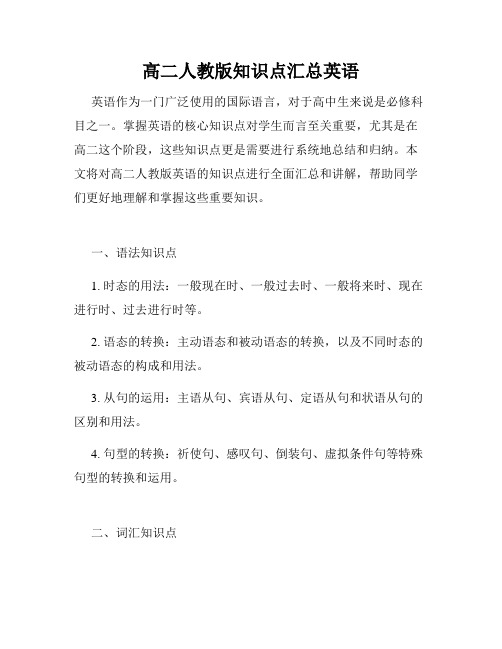
高二人教版知识点汇总英语英语作为一门广泛使用的国际语言,对于高中生来说是必修科目之一。
掌握英语的核心知识点对学生而言至关重要,尤其是在高二这个阶段,这些知识点更是需要进行系统地总结和归纳。
本文将对高二人教版英语的知识点进行全面汇总和讲解,帮助同学们更好地理解和掌握这些重要知识。
一、语法知识点1. 时态的用法:一般现在时、一般过去时、一般将来时、现在进行时、过去进行时等。
2. 语态的转换:主动语态和被动语态的转换,以及不同时态的被动语态的构成和用法。
3. 从句的运用:主语从句、宾语从句、定语从句和状语从句的区别和用法。
4. 句型的转换:祈使句、感叹句、倒装句、虚拟条件句等特殊句型的转换和运用。
二、词汇知识点1. 单词的拼写和词义辨析:常见单词的拼写规则和常见词义的辨析。
2. 短语和固定搭配的运用:常用短语和固定搭配的用法及在句中的运用方式。
3. 同义词和近义词的辨析:常见的同义词和近义词之间的区别和用法。
三、阅读理解1. 阅读技巧和策略:快速阅读、略读、精读和逆读等不同阅读技巧的使用。
2. 理解文章的主旨大意:通过标题、首尾句和段落关键词等来捕捉文章主旨。
3. 掌握不同题型的解题方法:主旨题、细节题、推理题、态度观点题等不同题型的解题思路和技巧。
四、写作技巧1. 作文的结构和要点:论述文、记叙文、议论文等不同类型作文的结构和写作要点。
2. 语言表达的准确性和逻辑性:语法准确性、词汇的丰富性、句子的连贯性和段落的逻辑性。
总结:以上所列举的知识点只是高二英语人教版教材中的一部分,但它们都是非常重要的,需要同学们认真学习和掌握。
在复习过程中,应该重点关注这些知识点,并通过大量的练习来提高自己的应用能力。
只有通过不断的学习和练习,才能在英语学习中取得更好的成绩。
相信通过努力和坚持,高二英语知识点的掌握对同学们来说将不再是难题。
加油吧,同学们!。
高二英语第一册知识点总结
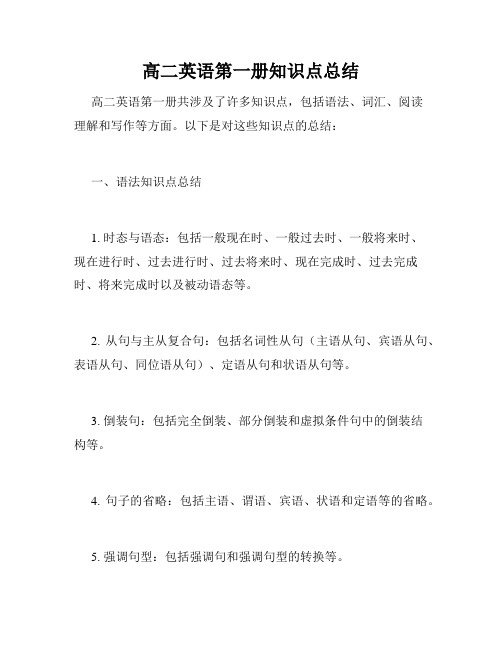
高二英语第一册知识点总结高二英语第一册共涉及了许多知识点,包括语法、词汇、阅读理解和写作等方面。
以下是对这些知识点的总结:一、语法知识点总结1. 时态与语态:包括一般现在时、一般过去时、一般将来时、现在进行时、过去进行时、过去将来时、现在完成时、过去完成时、将来完成时以及被动语态等。
2. 从句与主从复合句:包括名词性从句(主语从句、宾语从句、表语从句、同位语从句)、定语从句和状语从句等。
3. 倒装句:包括完全倒装、部分倒装和虚拟条件句中的倒装结构等。
4. 句子的省略:包括主语、谓语、宾语、状语和定语等的省略。
5. 强调句型:包括强调句和强调句型的转换等。
6. 并列连词与逻辑连词:包括and、but、or、if、unless、because、since、although、while等。
7. 句子成分与句型:包括主语、谓语、宾语、定语、状语、宾补和主谓一致等。
二、词汇知识点总结1. 词义辨析:包括常见的同义词、反义词和近义词的辨析。
2. 词性转换:包括名词、动词、形容词和副词等词性的转换。
3. 词形变化:包括单数变复数、动词时态变化、形容词和副词的比较级和最高级等。
4. 构词法:包括合成词、派生词和缩略词等词的构成规则。
5. 习惯搭配:包括动词短语、形容词短语和副词短语等的固定搭配。
三、阅读理解知识点总结1. 主旨大意题:通过阅读文章整体内容进行判断。
2. 词义理解题:通过上下文推测词义。
3. 推理判断题:通过文章中的线索进行推理判断。
4. 细节理解题:通过文章中的具体细节进行判断。
5. 作者意图题:通过分析作者的写作目的进行判断。
四、写作知识点总结1. 作文结构:包括开头、中间段落和结尾。
2. 写作技巧:包括扩展观点、使用连接词、注意时态和语态的使用等。
3. 遣词造句:包括使用丰富的词汇和变化多样的句式进行表达。
4. 表达清晰:注意使用适当的标点符号和语法结构,使文章表达清晰。
5. 作文类型:包括议论文、记叙文、说明文和应用文等不同类型的写作。
人教版高二英语上知识点总结
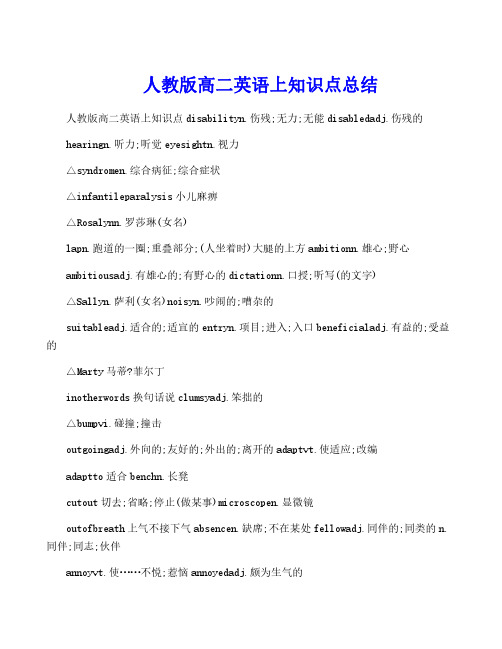
人教版高二英语上知识点总结人教版高二英语上知识点disabilityn.伤残;无力;无能disabledadj.伤残的hearingn.听力;听觉eyesightn.视力△syndromen.综合病征;综合症状△infantileparalysis小儿麻痹△Rosalynn.罗莎琳(女名)lapn.跑道的一圈;重叠部分;(人坐着时)大腿的上方ambitionn.雄心;野心ambitiousadj.有雄心的;有野心的dictationn.口授;听写(的文字)△Sallyn.萨利(女名)noisyn.吵闹的;嘈杂的suitableadj.适合的;适宜的entryn.项目;进入;入口beneficialadj.有益的;受益的△Marty马蒂?菲尔丁inotherwords换句话说clumsyadj.笨拙的△bumpvi.碰撞;撞击outgoingadj.外向的;友好的;外出的;离开的adaptvt.使适应;改编adaptto适合benchn.长凳cutout切去;省略;停止(做某事)microscopen.显微镜outofbreath上气不接下气absencen.缺席;不在某处fellowadj.同伴的;同类的n.同伴;同志;伙伴annoyvt.使……不悦;惹恼annoyedadj.颇为生气的△annoyancen.烦恼allinall总而言之firmn.公司adj.结实的;坚固的;坚定的softwaren.软件sitaround闲坐着aswellas和;也parrotn.鹦鹉tankn.(盛液体、气体的)大容器;缸;大桶tortoisen.陆龟;龟inmanyways在很多方面psychologyn.心理(学)psychologicallyadv.心理(学)地makefunof取笑encouragementn.鼓励;奖励conductn.行为;品行vt.指挥;管理;主持△mainstreamn.主流;主要倾向△fulfillingadj.令人满意的;令人愉快的nevermind不必担心politicsn.政治(学)abolishvt.废除;废止△abolitionn.废除;废止resignvi.&vt.辞职;辞去(工作、职位等)slaveryn.奴隶制literaturen.文学(作品);著作;文献△BarryMinto巴里?明托assistancen.协助;援助congratulatevt.祝贺;庆贺congratulationn.祝贺;贺词bowlingn.保龄球graduationn.;毕业典礼certificaten.证书allthebest(口语)(祝你)一切顺利architectn.建筑师△Sandersn.桑德斯(姓)adequateadj.足够的;充分的accessn.(接近的);通路;可接近性accessibleadj.可接近的;可进入的;可使用的△wheelchairn.轮椅handyadj.方便的;有用的△earphonen.耳机△impairvt.削弱;损伤rown.一行;一排vt.&vi.划(船)basementn.地下室outwardsadv.向外exitn.出口;离开;退场meetwith遇到;经历;会晤approvaln.赞成;认可dignityn.尊严;高贵的品质profitn.收益;利润;盈利kingdomn.王国consistv.组成consistof由…组成LondonHeathrowAirport伦敦希思罗机场provincen.省RiverAvon埃文河RiverThames泰晤士河RiverSevern塞文河divide…into把…分成Wales威尔士Scotland苏格兰NorthernIreland北爱尔兰clarifyv.澄清breakaway(from)挣脱(束缚)unionn.联合theUnionJack英国国旗creditn.信任toone‘scredit为……带来荣誉currencyn.货币institutionn.制度educationadj.的conveniencen.便利roughadj.粗糙的roughlyadv.粗略地Midlands英格兰中部地区nationwideadj.全国性的attractv.吸引historicaladj.历史(上)的architecturen.建筑学Romann.(古)罗马collectionn.品administrationn.管理portn.港口Anglo-Saxonn.盎格鲁-撒克逊人Normann.诺曼人Vikingn.北欧海盗countrysiden.乡下enjoyableadj.令人愉快的leaveout省去opportunityn.机会descriptionn.描写furnishedadj.配备好装备的faxn.传真(机)possibilityn.可能性plusprep.加上quarreln.争吵alikeadj.相同的taketheplaceof代替breakdown损坏arrange筹备weddingn.婚礼foldv.对折sightseeingn.观光delightn.快乐royaladj.王室的uniformn.制服StPaul‘sCathedral圣保罗大教堂splendidadj.壮丽的WestminsterAbbey威斯敏斯特教堂statuen.雕像BuckinghamPalace白金汉宫Greenwich格林尼治longituden.经线imaginaryadj.想象中的navigationn.导航thrillv.使激动potn.罐errorn.错误tensen.时态consistentadj.一致的回答反义疑问句时,若事实是肯定的,用yes回答;若事实是否定的,就用no来回答。
2023最新人教版高二上英语期末复习知识点总结

2023最新人教版高二上英语期末复习知识点总结高二上英语期末复习知识点总结:一、语法知识1、定语从句:关系代词who/whom, which/that, whose, when, where, why;定语从句的种类:限制性定语从句和非限制性定语从句;2、独立主格结构:it作形式主语,用来引导主语从句,省略句子的主语从句部分或修饰动词;3、不定式:不定式分为完成式和省略式,包括带to, 带不定式符号的省略式不定式,不带to, 带不定式符号的省略式不定式,省略式不定式中宾语从句时可以省略;4、动词:谓语动词由不同时态构成,包括一般现在时,一般过去时,一般将来时,现在进行时,过去进行时,现在完成时,过去完成时,现在完成进行时,过去完成进行时;助动词have, be, do, shall, will, can, must, need等;情态动词might, should, would, could, ought to等。
二、词汇知识1、英语单词拼写:要准确拼写所学单词,避免拼写错误;2、词性转换:理解和掌握词形变化规律,如形容词,动词,名词,副词等的变化;3、固定搭配:了解和掌握不可分割的固定搭配,如think of, look for, take off, take away等;4、词义辨析:辨析以下类似单词的意义:set(设定,安装)、put(安装,放置)、lay(铺设,放置)、put on(穿上,戴上)。
三、句型结构1、简单句:主语 + 谓语动词 + 其他,如The boy plays basketball.;2、并列句:并列句中要注意平行结构,两个句子要用同种语法形式,如He likes eating apples and oranges.;3、复合句:复合句由主句和从句构成,从句必须有完整的主语和谓语动词,如I think that he is a good student.;4、倒装句:倒装句是将一般句子的主语和谓语动词调换顺序,如Here comes the bus.四、阅读理解1、了解阅读材料:先通读文章,理解文章的大意;2、逻辑推理:从文章中把握作者的思路,对文章中的事实和观点作出正确的推理;3、定位信息:快速定位文章中的关键信息,找出问题的答案;4、抓住要点:抓住文章中的重要信息,如事件,人物,时间,地点等。
高二英语上知识点梳理
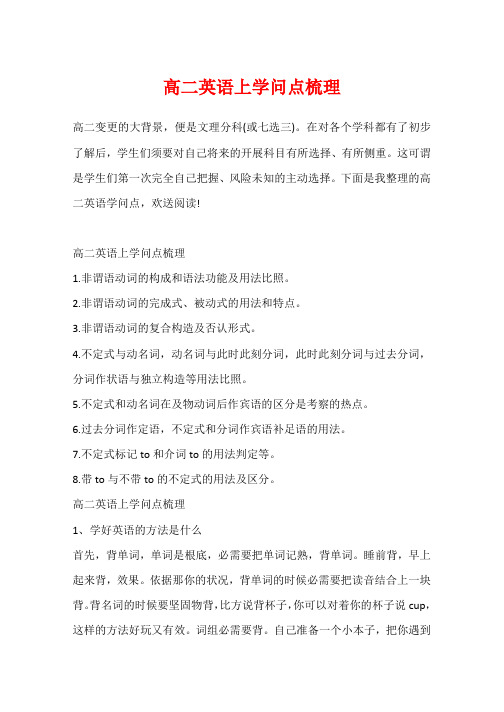
高二英语上学问点梳理高二变更的大背景,便是文理分科(或七选三)。
在对各个学科都有了初步了解后,学生们须要对自己将来的开展科目有所选择、有所侧重。
这可谓是学生们第一次完全自己把握、风险未知的主动选择。
下面是我整理的高二英语学问点,欢送阅读!高二英语上学问点梳理1.非谓语动词的构成和语法功能及用法比照。
2.非谓语动词的完成式、被动式的用法和特点。
3.非谓语动词的复合构造及否认形式。
4.不定式与动名词,动名词与此时此刻分词,此时此刻分词与过去分词,分词作状语与独立构造等用法比照。
5.不定式和动名词在及物动词后作宾语的区分是考察的热点。
6.过去分词作定语,不定式和分词作宾语补足语的用法。
7.不定式标记to和介词to的用法判定等。
8.带to与不带to的不定式的用法及区分。
高二英语上学问点梳理1、学好英语的方法是什么首先,背单词,单词是根底,必需要把单词记熟,背单词。
睡前背,早上起来背,效果。
依据那你的状况,背单词的时候必需要把读音结合上一块背。
背名词的时候要坚固物背,比方说背杯子,你可以对着你的杯子说cup,这样的方法好玩又有效。
词组必需要背。
自己准备一个小本子,把你遇到不会的题解决之后记到一个小本子上。
其次,要多读,多张嘴,这样可以快速提高语感,在做完型填空的时候就很会很简洁得选出答案。
做题的时候可以不依据语法也能做对题。
然后,必需每天坚持做阅读,阅读在考卷中占得比例特殊大,所以必需要多做。
要有耐性。
印刷体练一下。
最终,多背一些作文模板,在考试的时候可以把一些亮点的句子用到作文中。
2、学好英语有哪些窍门假如能够接触到不一样的语言环境,对你学习英语会很有帮助,是能够到说英语的人多的地方去沟通学习,假如每天早上我们听到的都是英语,经过几个月,我们的英语也会见长很多,我们必需要去学会学习自己不相识的单词,也就是要大量的积累单词和词汇,此时此刻有很多人会写英语但是不会说,也有很多人会说,但是不相识英语单词,这两种人,其实都是要学习,只有两者都兼顾了,我们的英语才算真的学好了。
- 1、下载文档前请自行甄别文档内容的完整性,平台不提供额外的编辑、内容补充、找答案等附加服务。
- 2、"仅部分预览"的文档,不可在线预览部分如存在完整性等问题,可反馈申请退款(可完整预览的文档不适用该条件!)。
- 3、如文档侵犯您的权益,请联系客服反馈,我们会尽快为您处理(人工客服工作时间:9:00-18:30)。
人教高二英语上册知识点大汇总目录Unit1 Great scientists 知识点归纳 (2)Unit2 The United Kingdom 知识点归纳 (6)Unit3 Life in the Future 知识点归纳 (10)Unit4 Making the News 知识点归纳 (14)Unit5 First aid 知识点归纳 (22)Unit 1 Great scientists 知识点归纳【重点词汇、短语】1. put forward 提出2. conclude 结束,结论3. draw a conclusion 得出结论4. defeat 打败5. attend 照顾,护理,出席6. expose to 使显露7. cure 治愈,治疗8. challenge 挑战9. suspect 怀疑,被怀疑者10. blame 责备11. handle 柄,把手,处理,掌控12. link 联系,连接13. link to 将…和…连接14. announce 宣布15. contribute 捐献,贡献16. apart from 除了17. be strict with 对…严格18. make sense 讲的通,有意义19. spin 使旋转20. reject 拒绝,抛弃【重点句型】1. What do you know about infectious diseases?你对传染性疾病了解多少?2. John Snow was a famous doctor in London –so expert, indeed, that he attended Queen Victoria as her personal physician.约翰•斯诺是伦敦一位著名的医生——他的确医术精湛,因而成为维多利亚女王的私人大夫。
3. But he became inspired when he thought about helping ordinary people exposed to cholera.但当他一想到要帮助患了霍乱的普通老百姓,他就感到很振奋。
4. Neither its cause, nor its cure was understood.人们既不知道它的病源,也不了解它的治疗方法。
5. He knew that cholera would never be controlled until its cause was found.他知道,在找到病源之前,霍乱疫情是无法控制的。
6. The second suggested that people absorbed this disease into their bodies with their meals.第二种看法是在吃饭的时候人们把这种病毒引入体内的。
7. John Snow suspected that the second theory was correct but he needed evidence.约翰•斯诺猜想第二个理论是正确的,但他需要证据。
8. It seemed that the water was to blame.看来要归罪于饮用水了。
9. He immediately told the astonished people in Broad Street to remove the handle from the pump so that it could not be used.约翰•斯诺马上叫宽街上惊惶失措的老百姓拆掉水泵的把手,这样水泵就用不成了。
10. In another part of London, he found supporting evidence from two other deaths that were linked to the Broad Street outbreak.在伦敦的另一个地区,他从两个与宽街爆发的霍乱有关联的死亡病例中又发现了有力证据。
【语法总结】过去分词作定语和表语一. 过去分词作表语作表语用的过去分词表示主语的特点或所处的状态,相当于形容词,强调主谓关系;被动语态表示动作,强调动宾关系,绝大多数被动结构中的行为执行者还可以用by短语来表示。
1. 过去分词做表语与被动语态的差异:The store is now closed.(系表)The library is usually closed at 8:00 p.m. (被动)2. 某些过去分词作表语,多半用来表示人物所处的心理状态或情感变化, 其主语主要是人。
这类过去分词通常为下列过去分词: delighted, devoted, discouraged , astonished, frightened, excited, inspired, encouraged, interested, contented, pleased, puzzled, satisfied, tired, worried, ect .二. 过去分词作定语作定语的过去分词相当于形容词,其逻辑主语就是它所修饰的名词。
及物动词的过去分词作定语,既表被动又表完成;不及物动词的过去分词作定语,只表完成。
1. 过去分词用作定语,如果是单个的,置于其所修饰的名词之前。
We must adapt our thinking to the changed conditions.我们必须使我们的思想适应改变了的情况。
2. 过去分词短语用作定语时,置于其所修饰的名词之后,其意义相当于一个定语从句,但较从句简洁,多用于书面语中。
The concert given by their friends was a success.他们朋友举行的音乐会大为成功。
3. 过去分词短语有时也可用作非限制性定语,前后常有逗号。
The meeting,attended by over five thousand people,welcomed the great hero.他们举行了欢迎英雄的大会,到会的有五千多人。
Unit 2 The United Kingdom 知识点归纳【重点词汇、短语】1. consist 组成,在于,一致2. consist of 由…组成3. divide…into 把…分成4. break away from 脱离5. to one’s credit 在…的名下,为…带来荣誉6. attract 吸引,引起注意7. leave out 省去,遗漏,不考虑8. plus 加上,和,正的9. take the place of 代替10. break down 损坏,破坏11. arrange 安排12. fold 折叠,对折13. delight 快乐,高兴,喜悦【重点句型】1. How many countries does the UK consist of?联合王国由几个国家组成?2. You can easily clarify this question if you study British history.如果你学习了英国历史,很容易就能弄清楚这个问题。
3. Happily this was accomplished without conflict when King James of Scotland became King of England and Wales as well.令人高兴的是,这件事没有引起冲突就完成了,那时候苏格兰的詹姆斯国王也成为了英格兰和威尔士的国王。
4. However, the southern part of Ireland was unwilling and broke away to form its own government.然而,爱尔兰的南部却不愿意而分离出去了,并建立了自己的政府。
5. To their credit the four countries do work together in some areas.值得表扬的是,这四个国家的确在一些方面共同合作。
6. England is the largest of the four countries, and for convenience it is divided roughly into three zones.在这四个国家中,英格兰最大,为了方便起见,它大致被分为了三个地区。
7. You must keep your eyes open if you are going to make your trip to the United Kingdom enjoyable and worthwhile.如果你想要使你的英国之旅愉快又有意义,你就必须留心观察。
8. Worried about the time available, Zhang Pingyu had made a list of the sites she wanted to see in London.由于担心时间不够,张萍玉早就把她想在伦敦参观的地点列了一张单子。
9. It looked splendid when first built.刚建成的时候,它看起来真是金碧辉煌。
10. What interested her most was the longitude line.她最感兴趣的是那条经线。
【语法总结】过去分词作宾补过去分词作宾语补足语,说明宾语的状态或性质,过去分词所表示的动作和宾语有逻辑上的动宾关系。
一. 能接过去分词作宾语补足语的动词有三类:1. 表示感觉或心理状态的动词,如:see, hear, feel, watch, notice;think(认为), consider, find等。
We saw the thief caught by the police.我看见小偷被警察抓住了。
We thought the game lost.我们认为球赛输了。
2. 表示“致使”或“保持某状态”意义的动词,如:make, get, have, keep, leave 等。
Don’t leave such an important thing undone.不要让这么重要的事没有人做。
He had his hat blown away on his way home.在回家的路上他的帽子被吹掉了。
3. 表示“希望、要求、命令”等动词,如:want, wish, like, expect, order等。
I want the house white-washed before we move in.我想要房子在我搬进去之前粉刷完。
